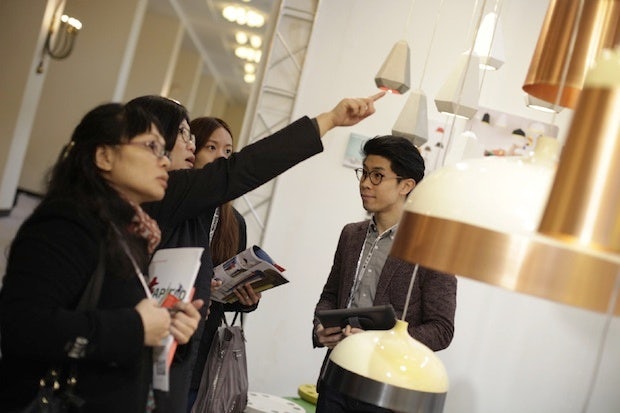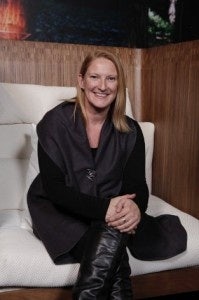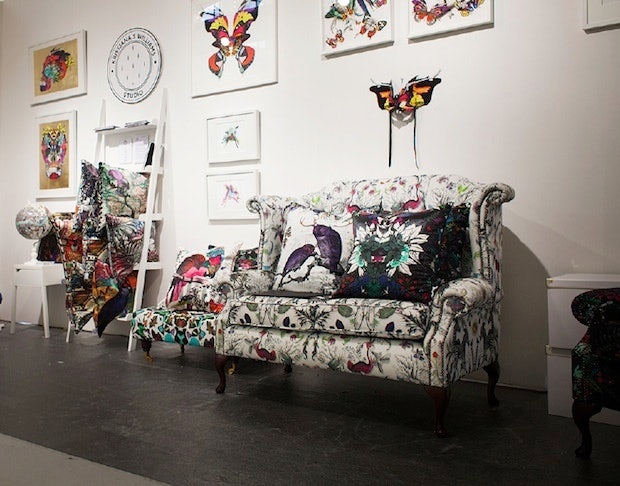
Attendees check out one of the displays at Design Shanghai 2014. (Design Shanghai)
From February 27 to March 2, China’s most progressive city hosted Design Shanghai, China's largest international design fair. Of the 150 predominantly foreign designers showcased at the fair, 90 percent were exhibiting in China for the first time. The inaugural event is timely, given the growing consumer demand for well-crafted items.
The prevalence of foreign brands was only part of the story, however—the fair also highlighted an organic movement within the local creative industry to transcend negative connotations of cheap and mass-produced “made-in-China” goods and attain a global status of “designed-in-China”, meaning a focus on high-quality and unique objects.
At the fair, Jing Daily got to sit and chat with Sharon Leece, one of the fair’s speakers, about evolving consumer tastes and what defines modern Chinese design. Leece is editor at large of AD China, China’s number one home and lifestyle magazine and author of China Style and China Modern, two comprehensive surveys of new design in greater China. Leece, who moved to Hong Kong in 1994, is also the former editor in chief of ELLE Decoration Hong Kong and helped launch ELLE Decoration China.

Sharon Leece.
How have Chinese consumer tastes changed in the past two decades?#
I think people are much more well informed. People travel, are exposed to good design—not just here, but around the world—so their taste levels are very different. Before, it was always a bit outward looking; you had to have your Italian or French, whereas now, there is a movement towards China designers producing high-quality work.
We [AD China] are focusing very much on that this year. We have brands like Shang Xia and Neri & Hu. They have a very strong vision, which is why they are successful. They keep to their aesthetic. I think people are beginning to appreciate design that is coming out of this country. Before, perhaps there wasn’t as much awareness of how there could be good quality and a cultural base to draw from. I don’t mean taking a Ming [dynasty] chair and making it more modern. It’s more subtle than that. That’s why we talked a lot about craftsmanship and the appreciation for one-of-a-kind pieces that are different and well made. They give a sense of personal style to a home and these are pieces they keep for a lifetime. It’s more sophisticated and authentic. We’re seeing more and more of that kind of vision that is unique and confident in its own style. There is an increased awareness and value given to craft and pieces that have meaning.
We [AD China] like to encourage moving from “made in China” to “designed in China”. I think that will continue to develop. You can see with our magazine, the audience really does range from fashion designers to celebrities to high-net-worth individuals who have money and taste, but also increasingly, a growing audience of more middle class who have an interest in design, so they use it as a source of inspiration and education as well.
We do position the magazine very much as lifestyle and not pure design and architecture as [in] the United States. In China, it’s rather different. But if you look at some European editions, the Spanish one is very design-led, for example. The Chinese edition has many similarities to that. The idea is to promote creativity in a way that is very appealing to people. It’s very lively; we like to show energy and life, to bring a sense of living. That’s what people want—you don’t want to live in a mausoleum. We try to balance.
What is the “modern” Chinese aesthetic?#
I think from our point of view, or the point of view I come from, I see a lot of combinations. Global information exchange is everywhere. The designs that appeal to me combine Chinese aesthetics with a very international outlook. If you ask a lot of Chinese designers why their design is Chinese, they will say they can’t articulate it but they know in their heart. Designs that have influences—but it’s not literal.
I think people are trying to find [that] in the materials, such as porcelain and wood, that designers here are very good with. A lot of it is very sculptural and just creating simple, beautiful forms that you can live with, that would work wherever you are in the world and don’t scream “China”. That’s what I like and what we like to expose through the magazine and through our work.

Displays at Design Shanghai. (Design Shanghai)
What are some Chinese designers to watch?#
Shang Xia, Neri & Hu, Design MVW, Song Tao, Kaolin, Banmoo, Atelier FCJZ, Spin Cermaics. Brand New China, and UCCA Store feature a great edit of some nice designers.
What is your take on brands that incorporate a contemporary twist on traditional Chinese aesthetics, such as Shang Xia? Do you think this is what Chinese consumers want?#
I like Shang Xia because I think they are true in their values. They are in it for the long game. They are not in it for the pure commercial. She’s [Jiang Qiong Er] looking at the craft industry and taking these amazing skills and repositioning the product. It’s a very nice synergy of contemporary. It’s out of a lot of people’s price points, but it’s an inspirational thing. I think where she leads, I hope others will follow at a more acceptable price point.
Especially among our team and editors in Shanghai and Beijing; they love the idea of crafts and traditions. They really value these elements and the idea of living with history because no one has done that for quite a long time here. We did an issue on craftsmanship late last year and a lot of shootings were in Taipei. Our team absolutely adored what they saw there. I saw how much my team really valued with what was going on there, and it resonated with them. It’s not here yet but maybe it will come.

A furniture display at Design Shanghai. (Design Shanghai)
What are some trends you see in Chinese design?#
I wouldn’t say they are new, but design has to be connected to what is going on in society, so craftsmanship and nature, it’s what people want. It has to add value to life and not just some abstract concept. Life is getting better, society is maturing, and the respect for materials and quality is growing. The nature idea is a response to the busy lives we all lead in an environment that can be challenging.
Perhaps here for the first time people are realizing they can have a second home or rent a villa or hotel for the weekend and enjoy that. All the development in Moganshan that’s what, two years old? There are options at all different price points. [It’s about] "I have a good quality of life, how can I improve it and add something extra?'" and that hasn’t been there before.
Whether it’s second homes or people just going for a while and staying in the countryside, now they build a life there, a business. We did a big feature on Dali, where people want to keep the environment alive, keep these villages with soul. In Dali, there is a film producer who lived in Beijing. Now his main house is there. A Taiwanese artist who has a studio in New York spends most his time there and has opened up his home for visitors.